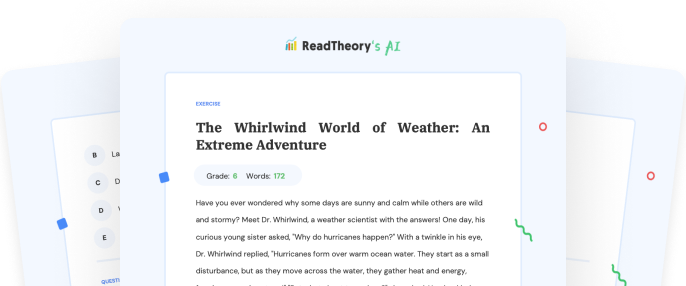Transform Your Teaching
with AI-Powered Worksheets
With ReadTheory’s Instant Worksheet Builder, you can create engaging, grade-appropriate worksheets tailored to your students in minutes. Spark curiosity, save time, and empower critical thinking with AI-powered tools designed for teachers like you.


Celebrating Diversity: The Lunar New Year
Have you ever heard of the Lunar New Year? Unlike the New Year celebrated on January 1st, which is based on the Gregorian calendar, the Lunar New Year is based on the lunar calendar, and the date changes every year!
The Lunar New Year, also known as Spring Festival in China, is the most important traditional holiday in many Asian countries. It's a time for family gatherings, feasts, and lots of fun. Each Lunar New Year is associated with an animal sign, according to the Chinese zodiac, which cycles every 12 years.
Food plays a crucial role in these celebrations. For instance, in China, it's customary to make dumplings. These delicious treats symbolize wealth because their shape resembles ancient Chinese gold ingots. In Vietnam, a traditional dish called 'Banh Chung' or sticky rice cake is prepared.
But it's not all about food. The Lunar New Year is also about new beginnings. It's a time to clean the house, settle old debts, and forgive past grudges to start the new year fresh.
So, the next time you hear about the Lunar New Year, remember it's a celebration of family, food, and fresh starts. It's a testament to the rich tapestry of cultures in our world, each with their own unique traditions and celebrations.
Question 1
What is the Lunar New Year based on?
Gregorian Calendar
Solar Calendar
Lunar Calendar
Ancient Roman Calendar
Mayan Calendar
Question 2
What does the food, particularly dumplings, symbolize in Lunar New Year celebrations?
Health
Family Reunion
Wealth
Longevity
Good Luck
Question 3
What is the Lunar New Year also known as in China?
Mid-Autumn Festival
Dragon Boat Festival
Qingming Festival
Spring Festival
Double Ninth Festival
Question 4
What does the Lunar New Year represent besides food and family reunion?
Harvest Celebration
Celebration of Marriage
New Beginnings
War Victory
Commemoration of Ancestors
Question 5
How often does the animal sign associated with the Lunar New Year cycle?
Every 10 years
Every 5 years
Every 12 years
Every 20 years
Every 30 years
 or share via
or share via

Assign the ReadTheory pretest to determine students' reading levels.

Why Teachers Love
Instant Worksheet Builder?

Tailored Content for Every Student
Craft worksheets with passages and multiple-choice questions customized to your chosen topic and grade level, ensuring relevance and engagement.

Save Hours
of Prep Time
Our AI, Lexi, generates complete worksheets—passages, questions, and answers—in minutes, freeing you to focus on teaching, not planning.

Standards-Aligned Learning
Every worksheet is designed to boost reading comprehension and critical thinking, aligning seamlessly with State Standards to help your students shine.
Personalized teaching
for personalized learning
Browse worksheets created and refined by educators using Lexi—your source for inspiration and ready-to-use resources.


ReadTheory is free for Teachers to use.
Join thousands of educators using ReadTheory for free. Sign up today and start creating in just minutes!





